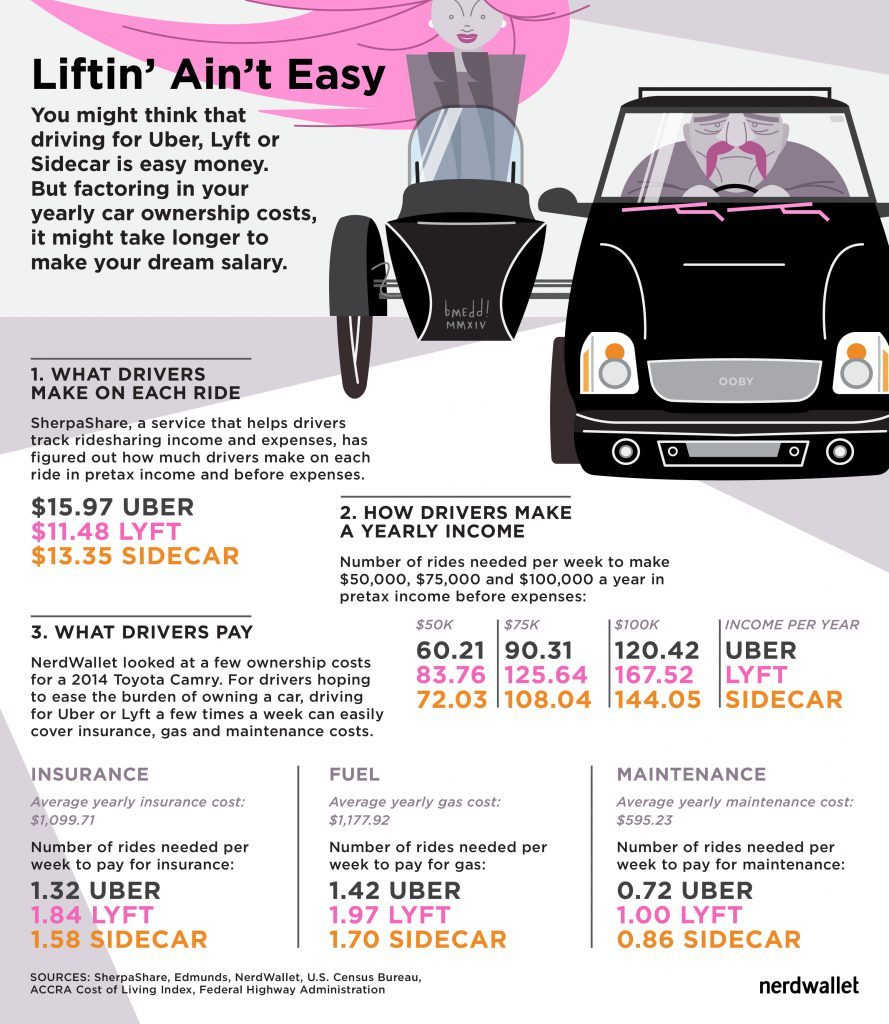
At times when the economy is pinching, some people are making money with ride-sharing apps like Lyft. Maybe some friends have even recommended you to do the same thing. But you’re probably having second thoughts like – is driving for Lyft worth it? This article aims to do most of the thinking for you and we’ll soon find out how much it actually takes to go behind the wheels.
Lyft Driving At a Glance
Lyft is an on-demand transportation company that was launched in 2012, currently servicing in the US and Canada. The job pays on a weekly basis through a revenue sharing model, which means, some of the profits will go to the company as commissions. Uber, the company that is more established worldwide is their competitor.
Driver’s Requirements
In order to be qualified, applicants must be 21 years old (and above), have a smartphone and an active driver license for at least one year. In terms of a car, the vehicle must be introduced in the year 2009 (or newer), covered with an insurance and can accommodate at least up to 4 passengers. As for oneself, it would be great to have a medical insurance in hand.
A personal background check will be conducted (no criminal records here) and this typically takes around 3 to 10 days period. Once approved, you can activate the Test Ride available in the app to learn about all the screens involved in completing a ride from start to finish.
For more details on how to use the driver app, please watch the video below.
Even though it’s not widely mentioned, a pleasant personality would help a lot in communicating with the passengers and even boost your job performance.
Now, let’s look at some of the good things first.
The Pros
1 – Basically, as an independent contractor (yes, you will be one when you drive for Lyft), there is a lot of time flexibility available. That means, your schedule isn’t tied to a certain time frame and you can actually choose when or when not to drive. Hence, this could be suitable for stay-at-home moms, retirees, of college students looking to earn some extra cash during their spare time.
2 – Driving around offers a lot of opportunity to explore different cities or suburbs that you’ve never been before. Also, if you are a bit on the social side, you get to know different people too.
3 – In the case of accident, especially one that occurs during working hours, the company provides liability coverage up to the amount of $1 million. This applies to injuries sustained by the passenger, anyone who is hit and the vehicle damage by other parties involved. For the drivers, there is also additional car insurance to keep you protected.
4 – So, how much can you make? Generally, the more you drive, the more you earn. Lyft has incentive programs that can pay between 10% to 20% more for your effort. Things like achieving a certain number of rides/week during peak hours, a certain number of rides/week total and maintaining a 90% acceptance rate are some of the goals that motivate people.
If you like to know the income potential on a daily to yearly basis, use this online calculator to estimate the earnings.
The Cons
1 – Due to the nature of the job, there’s actually no guarantee that you’ll be getting passengers at every hour. Think about all the other competitors who are also on the road (other Lyft drivers, Ubers and public transportation) so there are some down time to be expected while waiting for ride requests.
2 – If you’ve run through the estimator I’ve showed earlier, you’d come across the first variable – service location. Not all areas pay the same amount of baseline fee and rates, so that’s one thing to keep in mind. Busy cities pay more and suburbans could pay less.
The second variable is the cost of expenses on your side and these numbers play a major role in determining the net income that you’d be bringing home. Often overlook by most people, they consist of car payment, maintenance, phone plan and gasoline, just to name a few.

The figures may look small in the beginning, but those can quickly add up if you increase the driving capacity. More passengers means more clean-ups. Longer driving distances means more wear and tear to the car. You get the idea.
On top of that, don’t forget that Lyft also takes a 20% commission cut from every ride. Therefore, the net profit at the end of the day could differ, often times, much lower than expected if you factor in inflation rate as well.
3 – What you take home very much depends on the customer ratings. In fact, it’s also what contributes to the number of passenger request you get as a whole. Instances like dirty car, unpleasant personality, reckless driving, poor servicing and etc. are all the type of reviews that can be reflected in the driver’s portfolio. Lower ratings generally invite lesser request.
4 – You may not be aware of this, but your personal car insurance probably doesn’t provide coverage while they are driving for hire. So it’s actually wise to get a commercial liability insurance that specifically covers ride-sharing. Then, in the case of accidents, Lyft’s coverage is able to act as a supplement to that personal coverage.
5 – And just like all things that happen on the road, there are times when you’ll be faced with situations that you have no control over. For example, sloppy/drunk/furious passengers and the much dreaded traffic jams during rush hour. They don’t necessarily affect your pay, but can be a drag to your overall productivity.
So, Is Driving For Lyft Worth Your Time?
Now that I’ve given you the pros and cons, here’s how to look at it. Lyft is worth considering if you have no criminal background (obviously), you are pleasant and sociable AND most importantly, you don’t mind driving around town for the entire day or week.
However, it’s definitely not worth it for the long term if the weekly wages couldn’t meet your financial goals, whether it means fulfilling a personal dream or putting food on the table for the family. Of course, when the expenses become a burdening cost and starts eating into the profit, the job could be very hard to carry on.
The most crucial thing of all is the realization that your time is more valuable. Are you going to use that time to chauffeur people around for weekly wages, or are you going to create something more sustainable AND profitable?
If you are truly interested in achieving financial goals, one of the best ways is to start an online business. Why?
Because there are billions of people on the internet, searching for stuff every day and given today’s technology, it has never been easier to sell products/services through the online space. Even without any experience, you can begin by promoting other people’s product and make profits from commission revenue – just like how Lyft earn 20% from you.
Needless to say, you don’t need a car, you can start at 18 years old, you can work from anywhere in the world and the best of all, you can literally turn any passion into a business idea. Online marketing is a valuable skill in today’s economy that is worth much more than driving because it puts you in charge of your own time and money.
If you like to know what type of online business opportunities are available out there, check out this awesome entrepreneur platform to start your first training for free. Hope to see you inside.
Question – Have you used ride-sharing as a passenger or a driver before? What do you like or dislike about such service? We would like to hear your comments below.
You may also be interested in;
6 Online Business Ideas for Retirees To Keep You Busy
Can You Actually Make Money With Instacart
UberEats

Hi Cathy,
I think the advent of ride-sharing apps has made life somehow meaningful to many who could not secure a white collar job and has brought convenience to passengers alike, but of course not without it’s attendant risks.
I also think they should include passenger’s assessment of drivers to determine which drivers to keep in their employment and which ones to show the way out as my country has recorded cases of rape and thefts by Uber drivers.
Driving for a living is taxing. Money-wise or energy-wise!
Time and time again, I hear taxi drivers moan about how they do this almost round the clock and do not see their families as often as they would like. Obviously with Lyft, your hours are chosen to suit, but then if you cut too far back, your earnings suffer.
Not everyone can take time out to build a website like you or me. We are taking the easier way out, and though we put in a lot of work in the beginning, the income can skyrocket in a way a Lyft work cannot.
I’ve often wondered about these driver services and how they operate and pay in different areas of the world, mainly because I’m based in Wales, in a quite rural area.
In my area, we NEVER see these types of companies, not even in the cities, and I’m wondering if the difference in pay could be the reason why. You do mention that they pay more to drivers in the urban areas.
Nice,
I always wondered about Lyft as I have only experienced Uber. Everyone around me has been talking about picking up a job like this rideshareing due to slow season and I’ve wondered how the pros and cons weigh out.
The big thing that makes me worried is the 10-99 and insurance part.
A) you have to take out a certain percentage of what you make out just to pay it back at the end of the year. I feel like a lot of people don’t factor this expense!
B) Insured? The personal car insurance doesn’t provide coverage and you would need commercial Liability. This makes so much sense! Thanks for this great bit of info!
Overall I don’t know if the driving thing would be worth it unless you’re just looking to be social and hang out with some randoms in your car while your driving around town.
I think I’d rather make money in the comfort of my own home!
Hey really good article, i actually got disconnected for Lyft because of passengers lying. You deal with that all the time if passengers just want a free ride so i haven’t drove with Lyft for a long time. I do drive for Uber still though and I work on my online business on the side to try to succeed!